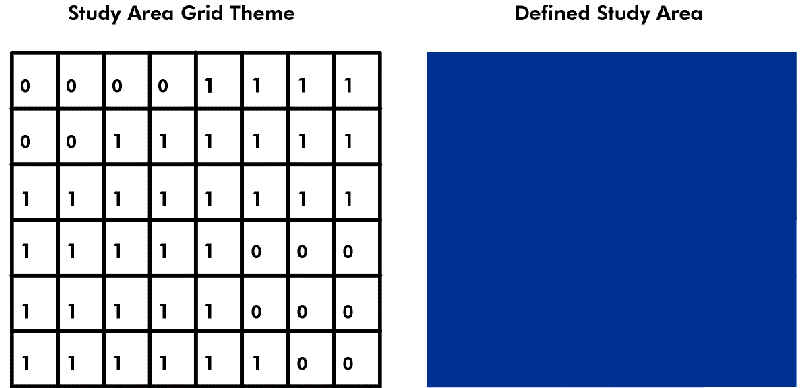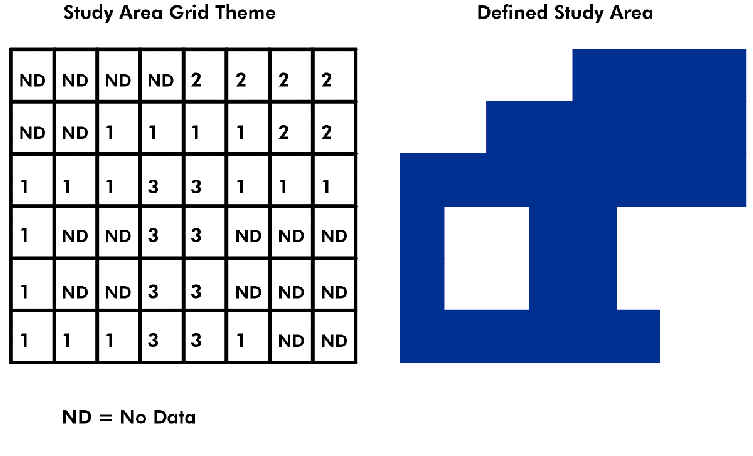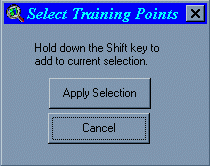This menu item opens the Weights of Evidence Analysis Parameters dialog box. Select this option to set and edit parameters. Each parameter is described below. Once the parameters are set they remain in effect until changed for any analysis done in the active View with the following exception:
The weights of evidence extension sets the theme you select for the Study Area Grid as the Mask in the current View’s Analysis Environment. This parameter can be changed via the Analysisà Properties… dialog. Check your analysis parameters before resuming any weights of evidence analysis to ensure that parameters are set as you expect.
What happens to the parameters you have set when you change views or reopen a project file
If you activate a View to which your Weights of Evidence analysis parameters do not apply, most of the Weights of Evidence menu items will be disabled and you will need to specify your parameters again before performing any analysis.
If you reopen a project file, the parameters are saved with the dialog, and should not have to be reset if you resume working with themes in the same View document.
| Next | Section Contents | Home |
Arc-WofE requires that a Grid Theme be specified as a Study Area Theme for the analysis. The Study Area Theme is a theme based on a grid data set that defines the geographic extent of the analysis study area. It is set as the Analysis Extents and Mask in the View's Analysis Environment.
Select Study Area Theme from Combo Box
The combo-box labeled 'Select Grid Theme' contains a list of all Grid Themes in the current view. Select the grid theme you want to use as the study area theme. The current Analysis Mask, if any, is displayed by default.
Selecting a new study area theme will cause the Study Area and Suggested Unit Area, in the 'Defining Area Units' panel of the dialog, to be recalculated.
How the Study Area Grid Theme defines your study area
'No Data' represents a Null cell value. It corresponds to -9999 in ARC/INFO.


| Next | Section Contents | Home |
What you can use as a Study Area Grid Theme
If you want to use a data set as both your Study Area Theme and as an Evidential Theme
ArcView on-line Help Topic: Cutting, copying and pasting themes
Make a copy of the Grid Theme:
Make your grid theme active by clicking on its legend in the View's Table of Contents
Select 'Copy Themes' from the 'Edit' menu.
Select 'Paste Themes' from the 'Edit' menu, or, press Ctrl-V to paste a copy of the Grid Theme into the View.
Ensure that the copy has a different name from the 'original' theme by renaming one or both themes:
To rename a theme:
Make the Grid Theme active by clicking on its legend in the View's Table of Contents
Select 'Properties' from the 'Theme' menu
Edit the Theme Name: and click 'OK'
You can also copy Themes to another View.
| Next | Section Contents | Home |
How you can create or prepare a Study Area Grid Theme
ArcView on-line Help Topic: Reclassifying the cell values of a grid theme
Reclassify one or more classes that define areas outside the study area to ‘No Data’
Set the Analysis Extent, Cell Size and Mask under the 'Properties' item in the Analysis menu.
Make the Grid Theme you want to reclassify active by clicking on its legend in the View's Table of Contents.
Select 'Reclassify...' from the 'Analysis' Menu
Type 'No Data' in the 'New Value' column for any of the rows that you want to reclassify to Null (areas outside the study area). 'Tab' out of the cell you are modifying to ensure that your edits register.
Click 'OK'
This will calculate the reclassified grid and add it to the top of the Table of Contents of the current View, with the name 'Reclass of' <Input Theme Name>.
Creating a "rectangular" Study Area Grid Theme
You can create a grid with cells containing a single value from scratch.
Click one or more digits in the number keypad to define the value you want to fill the grid's cells.
Click 'As Grid' to add the .AsGrid request to the grid definition.
Click 'Evaluate'.
You can also type the expression in the display window, although ArcView is finicky about format including spaces.
Convert a set of polygons whose extent defines the study area to a Grid
Click the Query
Builder ![]() button to open the query dialog; define a query to select
the polygon subset.
button to open the query dialog; define a query to select
the polygon subset.
| Next | Section Contents | Home |
The Training Point Theme is a point data set. For mineral exploration, each training point is a known mineral occurrence or deposit.
Usable file formats
ArcView on-line Help Topic: Add Event Theme (Dialog box)
NOTE: Arc-WofE will not work with a multi-point feature type, one of the feature types available in ArcView.
A subset of this point data set can also be used for analysis without creating a new data set.
Select a Training Point Theme from Combo Box
Select the data set you want to use as the training point theme. All point themes contained in the current view are available for selection. By default, a previously selected training point theme that exists as a theme in the current view will be displayed in the combo box.
Total Number of Training Points
The total number of points in the specified training point theme is displayed. If you have selected a subset of your training points, the total number of points in the subset is displayed. This number may be more than the total number of deposits used in weights calculations if one or more of the points fall outside the study area as defined by the study area theme.
You can determine how many of your
selected points fall in the study area by clicking on the
'Inspect Training Points' button, identified by the 'glasses'
icon.![]()
Expert Weights Only
If you do not have any training point data, but would like to perform an analysis using Arc-WofE's expert weights option, you can by-pass the selection of a Training Point Theme by checking the box labeled 'Expert Weights Only'. All other controls in the Training Point panel will be disabled.
Use all of your training points or a subset
You can toggle between 'All' of the points in your training point theme, or a 'Subset' of them by clicking the radio buttons labeled 'Select All' and 'Select Subset by:'. Clicking the 'Select Subset by:' applies the last defined subset if it is applicable to the currently selected training point theme. The buttons labeled 'Attributes', 'Random' and 'Location' are also enabled with the 'Select Subset by:' button is selected.
Clearing a subset
To clear a subset, click the 'Attributes' button, and then click 'OK' in the dialog box that appears. You can use any of these options to reduce or select a subset of your training point set.
| Next | Section Contents | Home |
Select a Subset by:
Attributes
You can define or change a subset of the training points based on its attributes by clicking the button labeled 'Attributes'. This displays ArcView’s Query Builder dialog.
Build your query and click 'OK'.
ArcView on-line Help Topic: Query Builder (Dialog box)
The total number of training points will now display the number of points identified by your query and the suggested unit area will also be updated below.
How Arc-WofE subsets the training point data set
The query will be applied to the training point theme as a 'definition'. All of the features, and their attribute records, not included in the definition will be hidden from your view. The definition query string is also set as an attribute of the theme's attribute table. You can see this query string by making your training point theme active and then selecting the 'Properties...' item from the 'Theme' menu. Click the 'Definition' option in the left column in the dialog box that appears. This definition is persistent, meaning that it will be reapplied to the point theme each time you reopen your project file.
Random
To make a random subset of training points, click the button labeled 'Random'. A dialog box is displayed which allows you specify either the number of records or the percentage of records you would like to include in the subset. If the you specify a percentage, you can see how many records this will include. Click 'OK' to make the random selection. The random selection of a subset of training points is done in two steps:
Generating Random Numbers
Arc-WofE will first look for a field called 'Random' in the attribute table of the specified training point theme. If not found, an integer field with this name will be appended to the data set. A random number between 1 and 1000 (ArcView's random number generator returns integers) will be generated for each record in the attribute table and then written to the new field.
If a field called 'Random' already exists in the attribute table, you will be asked if you want to overwrite the files contained in that field. Two things to consider when deciding to overwrite previously generated numbers are:
If you choose 'Yes', a new set of random numbers will be generated and written to the 'Random' field. If 'No', the selection will be made on existing values.
Selecting the Records
Starting at the lowest random number, the next highest random number is added to the subset until the number of records in the subset is what you specified. The subset is applied to the training point theme as a theme definition. Only the randomly selected features and their attribute records can be seen in the View and Table documents. The definition query string can be looked at by selecting 'Properties...' from the 'Theme' menu in the View document's interface.
Actually selecting the subset is like selecting a subset based on attributes. In fact, once the random numbers have been written to the theme's attribute table, you can re-establish the selection at a later time by clicking the Subset by: 'Attribute' button and querying the 'Random' field using the Query Builder (see above).
You can also interactively select a subset of your training point theme using the 'Select Points By Location...' item in the Weights of Evidence menu. A subset definition made this way will persist only for your current ArcView session.

To subset a point theme by location:
| Next | Section Contents | Home |
Maintaining a complete training point theme, as well as one or more subsets
You may want to have your complete training point theme available, as well as one or more subsets in your Views at the same time. For example, say you would like to maintain the complete set of training points, a randomly generated subset of the training points, and a second set of the points not included in the random subset. You could make these three themes as follows:
Make two copies of your training point theme by making the training point theme active and selecting 'Copy' from the 'Edit' menu. Select 'Paste' from the 'Edit' menu to paste a copy of the theme, or press Ctrl-V. Rename the copies of the training point theme.
Open the Arc-WofE parameters dialog box by selecting 'Analysis Parameters...' from the Weights of Evidence menu. Make your randomly selected subset using the steps described above and click 'OK'.
Open the Theme Properties dialog for the theme you just subsetted to see the definition query string. You can make an attribute query on the Random field to subset the remaining points. For example, if the query defining your random subset is ([Random] < 498) then to select the points excluded from this subset you could apply the query ([Random] >= 498).
| Next | Section Contents | Home |
Defining Area Units
What's displayed in the 'Defining Area Units' Panel
You need to define a unit area* that Arc-WofE will use as the area unit of measurement during weights calculations. Input a unit area in km2 in the text input line labeled 'Unit Area (Sq. km):' When you change the unit area, the total study area measured in units area will be updated.
The total study area given in km2 and in unit cell area in the Study Area/Unit Area of the Analysis Parameters dialog box are based on the area of Study Area Theme pixels containing values. The area reported in the weights area, for example the cumulative area of all classes in an evidential theme, may vary from this area because the output cell size differs from the cell or pixel size of the study area theme, or because the area of all classes in the evidential theme is less than the study area defined by the study area theme. The study area theme area is used as the total area in the weights formulas in these cases.
* see glossary for definition.
The Suggested Unit Area is calculated using the following equation:
suggestedValue = (totalStudyArea / total TrainingPoints) / 40
This suggested value is a guideline. Typically your unit area should be about the same or smaller than the suggested unit area.
The 'Advanced' Parameter Option
The screen capture of the parameters dialog, above, shows the dialog's basic configuration. If you click the button at the bottom right of the dialog, labeled 'Advanced >>', the dialog's Advanced configuration will be displayed. The 'Defining Area Units' panel of the dialog box is the only area of the dialog that is modified. All of the options available in the basic configuration remain and an additional option of using the a very small value of the unit area is added. As the unit area becomes infinitely small, the weights approach an asymptotic or limiting value.
Select this option by clicking the radio button labeled 'Use Limiting Value of Weights'.
| Next | Section Contents | Home |
Arc-WofE is able to handle areas of missing data in your evidential themes. How to define missing data areas and how these areas are handled during processing is discussed here. Missing data are also discussed in the following sections:
The Weights of Evidence calculations exclude any areas of missing data and training points that lie in these areas. When processing a set of Evidential Themes to arrive at a Response Theme, the areas and training points are adjusted on a theme by theme basis so that an area with data for one evidential theme will be included even though that area may be excluded from calculations for another evidential theme because data are missing. The integer that defines missing data must be the same in all Evidential Themes in order to create a Response Theme.
You can specify any integer to define areas of missing data. Type this integer in the text input line labeled 'Integer That Defines Missing Data:' The value you specify can be a positive or negative number, or zero. Areas with 'No Data' are assumed to be missing and are filled in 'on the fly' with the value you specify for missing data. These areas include grid cells defined as having the 'No Data' value or areas of a vector evidential theme where no polygon exists.
What to do if:
Your evidential theme has an area with no data.
Unless the area(s) with no data signifies something other than missing data, you probably do not have to edit your data sets. Arc-WofE will fill in these areas 'on the fly' with the missing data value you specify during parameter setup. In the case of calculating weights for a single evidential theme, the missing data value will be listed as the last class in the table. The area and number of training points will be reported and, if you specify the inclusion of a descriptor field, 'Missing Data' will be written to that field.
For a weights table for multiple evidential themes, a field called W<Missing Data Integer> will be included in the table. Zero will be written to this field if an evidential theme has any areas with missing data; the cell will be blank if there is not missing data in the theme.
| Next | Section Contents | Home |
Analysis Cell Size
The analysis, or output, cell size is not set using the 'Set Analysis Parameters' function. You can set or change the Analysis Cell Size by selecting the Properties... item from the Analysis menu in the View interface. For more information about the Analysis Properties and the Analysis Environment, please refer to 'What you need to know about ArcView and Spatial Analyst' or to the ArcView on-line Help Topic: Setting the analysis properties for a view
By default, the analysis cell size is the maximum size, or coarsest resolution, of grids input to a function. The response themes and output from buffering features is always in grid (raster) format.
Note that the analysis cell size and the unit area are unrelated.
| Next | Section Contents | Home |